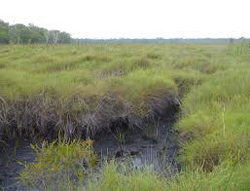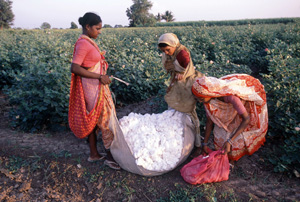March 2020 Environment
Sakshi Education
- Peatland protection will help attain climate goals
 Food and Agriculture Organization operating under the United Nations released a report cover only 3% of the earth’s surface; they trigger the carbon that was locked in a few decades.
Food and Agriculture Organization operating under the United Nations released a report cover only 3% of the earth’s surface; they trigger the carbon that was locked in a few decades.
About the report
The report says that peatlands consist of 30% of world soil carbon. They emit greenhouse gases. The climate peatlands occur in mangrove forests. Peatlands cover only three percent of Earth’s surface.
However, their degradation due to drainage, fire, agricultural use, and forestry can trigger the release of the stored carbon in a few decades. The publication, authored by 35 experts, highlights essential case studies from Indonesia, the Democratic Republic of the Congo and Peru in their attempts to map and monitor peatlands.
Peatlands contain 30 percent of the world’s soil carbon. According to Maria Nuutinen, co-author and FAO’s forestry officer, peatlands, a lot of drainage has happened since the time of the Roman Empire, both for cropping as well as grazing, particularly in Europe and Ukraine.
Mapping peatlands
Peatlands are formed due to the accumulation of partially decomposed plant remains over thousands of years under conditions of water-logging. For countries keen on reducing emissions, monitoring the groundwater level of peatlands is vital, or else they can turn into carbon emission sources.
Mapping methodologies include both ground and remotely-sensed input data. The report also offered an overview of the different monitoring approaches and their advantages and limitations.
According to the authors, mapping forms the basis. Without a map, there will be no sensible monitoring of peatlands. The monitoring exercise requires a mix of satellite and ground-based activities.
To facilitate countries’ access to a cloud computing-based and free monitoring platform as well as high-quality imagery, FAO has developed two state-of-the-art peatland restoration monitoring modules.
System for Earth Observation Data Access, Processing, and Analysis for Land Monitoring (SEPAL) platform contains a number of tools for land use and land-use change monitoring. Two of these modules are for peatlands.
- Scientists say Sikkim glaciers are losing mass faster than other parts of the Himalaya
Scientists from the Wadia Institute of Himalayan Geology (WIHG), Dehradun found that glaciers in Sikkim are melting at a higher magnitude as compared to other Himalayan regions.
Study Highlights:
The scientists assessed the response of 23 glaciers of Sikkim to climate change for the period of 1991-2015. It revealed that the glaciers in Sikkim have retreated and deglaciated significantly from 1991 to 2015.
Small-sized glaciers in Sikkim are retreating while larger glaciers are thinning due to climate change.
It stated that when compared to other Himalayan regions, the magnitude of dimensional changes and debris growth is higher in the Sikkim.
The western and central Himalaya glaciers are reported to have slowed down in recent decades, but the Sikkim glaciers have shown negligible deceleration after 2000.
It highlighted that the behavior of glaciers in the region seems to adopt different mechanisms to cope with the ongoing climatic changes.
- FAO reports peatlands can help attain climate goals
Food and Agriculture Organization (FAO) of the United Nations reported that Peatlands can play a crucial role in regulating the global climate by acting as carbon sinks. The report was authored by 35 experts.
Report Highlights:
The report recommended countries to restore and manage the Peatland ecosystems as these land are facing degradation.
Peatlands cover only 3% of Earth's surface. The degradation of the land occurs due to drainage, fire, agricultural use, and forestry. It can trigger the release of stored carbon in a few decades.
It highlighted important case studies from Indonesia, the Democratic Republic of the Congo and Peru in their attempts to map and monitor peatlands.
Peatlands:
Peatlands contain 30% of the world's soil carbon. These lands are formed due to the accumulation of partially decomposed plant remains over thousands of years under conditions of water-logging.
When drained, the lands emit greenhouse gases (GHGs). It contributes up to one gigaton of emissions per year through oxidation. Peatlands are currently facing degradation. This can be controlled by monitoring and mapping.
The groundwater level of peatlands should be continuously monitored as it can turn into carbon emission sources.
The mapping of Peatlands will tell the location of the peat and its condition. Mapping, along with conservation and restoration measures, will help to maintain water regulation services. The report provided methodologies to map the peatlands.
- NBRI develops pest-resistant variety of cotton against whiteflies
 National Botanical Research Institute (NBRI), Lucknow has developed a pest-resistant variety of cotton against whiteflies.
National Botanical Research Institute (NBRI), Lucknow has developed a pest-resistant variety of cotton against whiteflies.
The field test trials will begin from April to October at the Faridkot Center of Punjab Agriculture University, Ludhiana.
Highlights:
Whiteflies are one of the top devastating pests in the world that can damage more than 2000 plant species. It also functions as vectors for some 200-plant viruses.
Cotton is one of the worst-hit crops by the Whiteflies. In the year 2015, two-third of the cotton crop was destroyed by the pest in Punjab.
Researchers explored 250 plants to develop the pest-resistant variety from lower plant biodiversity to identify novel protein molecules that are toxic to whitefly.
During the trial, the leaves were extracted from all the plants. They were prepared separately. Then, the whiteflies were led to feed on a total of 250 plants. It was observed that the leaf extract of the edible fern Tectaria macrodonta caused toxicity to the whitefly.
This fern is known as a salad in Nepal. The plant worked against whiteflies but being safe for application on the crop plants and provides protection from the plant.
As the whiteflies fed on sub-lethal doses of insecticidal protein, it resulted in very poor egg-laying, abnormal egg, nymph, and larval development and extraordinary poor emergence of the fly.
The test also showed that the protein is specifically toxic only to whitefly and does not cause any harmful effects on other beneficial insects like butterfly and honeybee.
- Worlds only female white Giraffe and calf killed by Poachers
 Conservationist stated that Kenya's only female white Giraffe and her calf had been killed by poachers.
Conservationist stated that Kenya's only female white Giraffe and her calf had been killed by poachers.
White giraffes are rare animals that aren't found anywhere else in the world. Now, only one white Giraffe, a lone male borne by the same slaughtered female, is alive.
White Giraffe:- White Giraffe is leucistic and not albino. The white Giraffe has a genetic condition that inhibits pigmentation in skin cells.
- Due to leucism, they continue to produce dark pigment in their soft tissue, giving them dark eyes.
- GoI, World Bank signs loan agreement on Integrated Project for Source Sustainability and Climate Resilient
The World Bank signed an $80 million loan agreement with the Government of India, Government of Himachal Pradesh on 11 March 2020.
The aim is to improve water management practices and increase agricultural productivity in selected Gram Panchayats in Himachal Pradesh.
The loan from the International Bank for Reconstruction and Development (IBRD) has a final maturity of 14.5 years, including a grace period of 5 years.
Highlights:
The Integrated Project for Source Sustainability and Climate Resilient Rain-Fed Agriculture will be implemented in 428 Gram Panchayats in 10 districts in Himachal Pradesh.
The project includes setting up of hydrological monitoring stations to monitor water quality and quantity.
It is expected that it will benefit over 400,000 smallholder farmers, including women, and pastoral communities.
The project aims to make the best use of all available technologies and resources to increase water-use efficiency.
It will improve upstream water sources in pastures, forests, and grasslands.
The project will enhance the climate resilience of agriculture and its allied activities and also ensure sufficient water is available for sustainable agriculture both in Himachal Pradesh and in downstream states.
- Newly discovered treehopper species named after Lady Gaga
A newly discovered species of treehopper was named after the singer, song writer- Lady Gaga. The insect species has been named as Kaikaia Gaga.
It was named by Brendan Morris, a University of Illinois, a PhD entomology student.
Kaikaia Gaga:
Kaikaia Gaga is a part of the family Membracidae. The species is around 40 million years old. K. gaga was found nearly 30 years ago in a tropical forest near the Pacific coast of Nicaragua.
The bugs are known for their bright coloring and individuality in appearance. It sings to each other by vibrating plant stems.
- Maharashtra to become single-use plastic-free by 1 May
 Maharashtra State government is set to become single-use plastic-free by 1 May 2020.
Maharashtra State government is set to become single-use plastic-free by 1 May 2020.
The announcement was made by the State environment minister Aaditya Thackeray.
Highlights:
The ban on plastic bottles cannot be implemented in the state as clean drinking water is still not universally available in the state.
The drive against single-use plastic has been taken against 53 manufacturers so far. All their units have been shut down.
As an alternative measure, the used plastic bags will be used in road repairs. Around 7% of plastic is being used for building roads, and for buyback in the state which has decided to pay Rs.15 per kg.
The state government has announced that the self-help groups will be given Rs.5 crore to procure cloth bags.
- Thirty Three crores allocated for Kaziranga under Project Tiger scheme
Financial assistance to the tune of Rs 1.51 crore sanctioned to Kaziranga National Park during the fiscal years 2018-19 and 2019-2020 under Compensatory Afforestation Fund Management and Planning Authority (CAMPA).
Minister of State for Environment, Forest and Climate Change Babul Supriyo said that Rs 94,46, 585 and Rs 51,24,670 sanctioned to Kaziranga National Park during the financial years 2018-19 and 2019-2020 respectively under CAMPA.
Project Tiger scheme
Project Tiger scheme financial assistance of Rs 10.30 crore and Rs 22.81 crore were allocated by the government. It is a conservation program launched in April 1973 by the Government of India during Prime Minister Indira Gandhi's tenure.
The project aims at ensuring a viable population of Bengal tigers in their natural habitats, protecting them from extinction, and preserving areas of biological importance as a natural heritage forever represented as close as possible the diversity of ecosystems across the distribution of tigers in the country.
Government of Assam
The Assam government informed the Centre that it has taken a number of steps to protect wildlife in national parks, including the deployment of frontline forest staff. In addition, the Assam Forest Protection Force, Special Rhino Protection Force, and Home Guards are supplementing the regular frontline forest staff to protect wildlife.
Highlands and platforms have also been constructed in national parks to give shelter to animals during the high flood.
Anti-poaching camps in strategic locations have also been built with sufficient armed guards, besides deployment of boats during flood and use of modern technologies like 'electronic eye' for smart patrolling.
- Genetic study shows that there are two separates species of red panda
Scientists from the Chinese Academy of Sciences discovered that there are two distinct species of Red pandas namely Chinese red pandas and Himalayan red pandas.
Substantial divergences have been found among the species. The scientists found three genetic markers in an analysis of DNA from 65 of the animals.
The recognition of the existence of two separate species is expected to guide conservation efforts for the mammal.
Red Pandas:
Red Pandas are bushy-tailed and russet-furred bamboo munchers. They dwell in Asian high forests. The two species differ in coloration and skull shape. The YaluZangbu River marks the geographical boundary that separates the two species. Earlier, it was believed that Nujiang River was the geographical boundary.
A total population of roughly 10,000 red pandas in the wild has been estimated so far. The species is listed as Endangered on the International Union for Conservation of Nature (IUCN) Red List because of the wild population.
Chinese red pandas:
Chinese red pandas are found in northern Myanmar, southeastern Tibet, Sichuan and Yunnan provinces in China.
Himalayan red pandas:
Himalayan red pandas are native to India, Nepal, Bhutan and southern Tibet in China. This panda is the scarcer of the two. Also, it needs urgent protection because of low genetic diversity and small population size.
Scientists also said that interbreeding between species may harm the genetic adaptations already established for their local habitat environment.
Red pandas have a short snout, pointed ears, thick fur. The animal spends much of their life in trees. Deforestation and degradation of their habitat due to human development remains a major threat to the red panda.
- Scientists say Black carbon might influence melting of Gangotri Glacier
Scientists from Wadia Institute of Himalayan Geology (WIHG) said that black carbon concentration in the Gangotri glacier was increased by 400 times during summer.
Report Highlights:
The study suggested the reason behind this seasonal increase is agricultural burning and forest fire.
Along with agricultural burning and forest fire, the long-range transport of pollutants in winter, also influence the melting of Glacier.
The light-absorbing nature of black carbon can trigger glacial melt.
A study on Chirbasa station near Gangotri Glacier found that black carbon (BC) concentration changed from 0.01µgm-3 in winter to 4.62µgm-3 during summer, for the year 2016.
Equivalent Black Carbon (EBC):
EBC aerosols contribute significantly to global warming because of its light-absorbing nature. The presence of EBC in the eco-sensitive zone, like the Himalayan glacier valleys, should be monitored meticulously. However, baseline data on BC is rarely available from most of the glaciated Himalayan region.
Published date : 30 Mar 2020 08:27PM


















